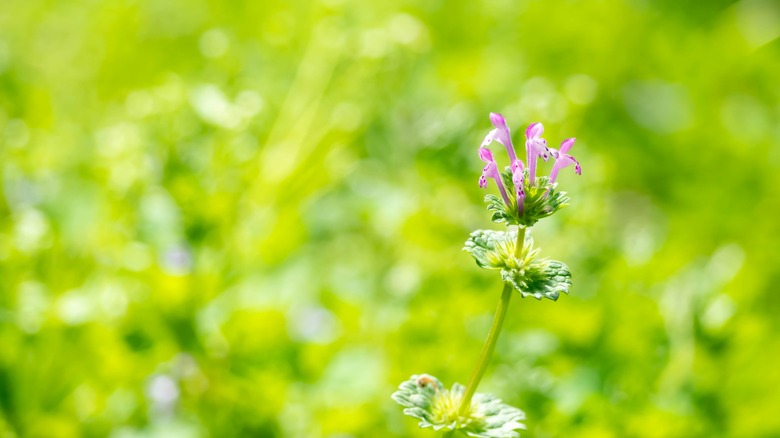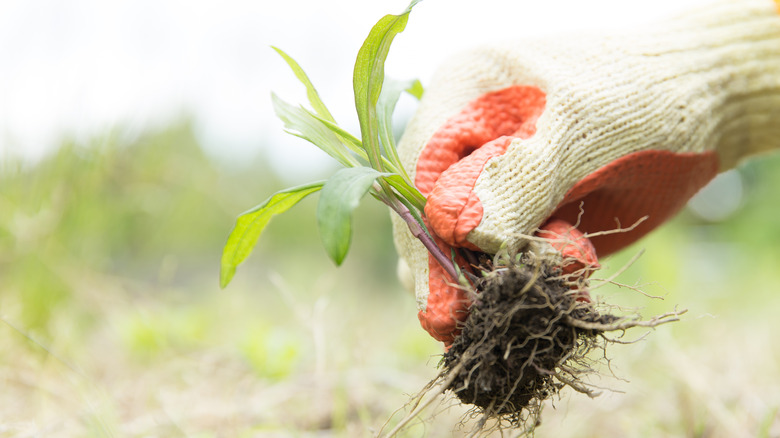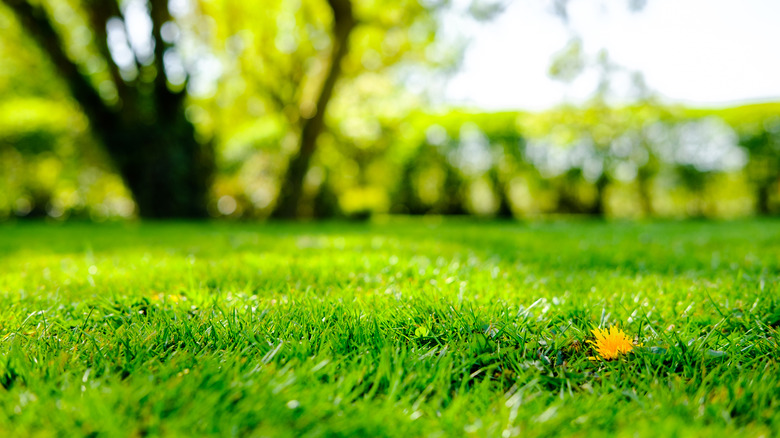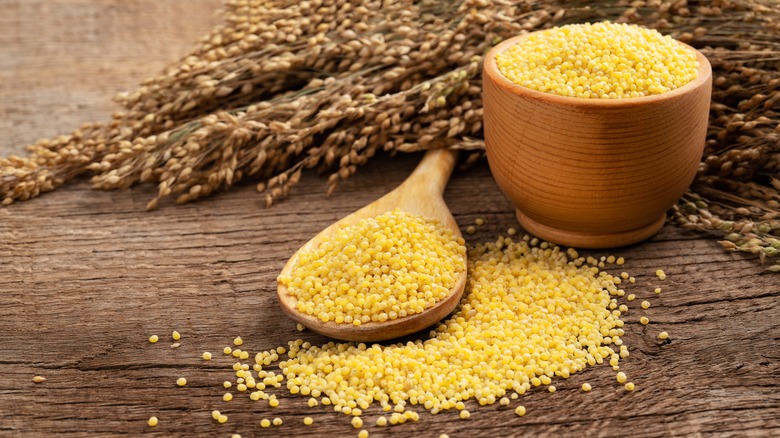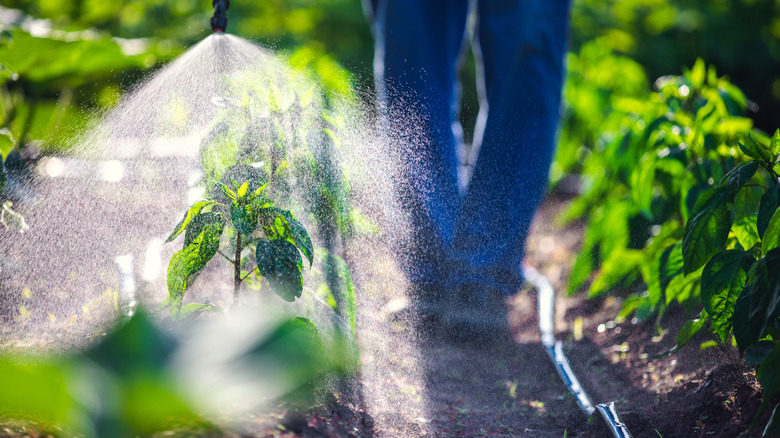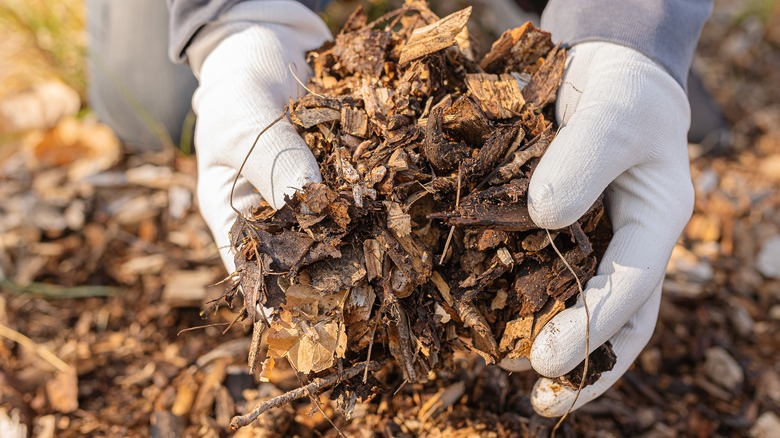How To Get Rid Of Henbit And Chickweed
Henbit and chickweed are two flowering annuals, which, while somewhat attractive, are weeds that can seriously inhibit the growth of crops and flowers and negatively impact the overall appearance of your yard, as explained by Tree Top Nursery & Landscaping. Both the weeds start to show up in the fall, then spread and flower in the spring, and, finally, die off in the summer heat.
Henbit is identifiable by its purple, trumpet-shaped flowers and somewhat fuzzy, scalloped leaves. It isn't necessarily a weed as much as it is a quick-spreading and wild member of the mint family, according to Family Handyman. That being said, it is actually a great food source for wild bees and even humans. However, most people don't like it growing in their garden.
Chickweed produces small white flowers and is a little bit more dangerous than henbit. While it is edible for both humans and poultry, as the common name would imply, as well as serving as a food source for bees and other pollinators, it can attract bugs and pests that can seriously damage nearby plants and crops. Luckily, henbit and chickweed both behave similarly and can be treated in almost the same way.
Pull them up by hand
The first, and most obvious, way to get rid of both henbit and chickweed is to simply gear up with some garden gloves and pull them up by hand. That being said, Growing Herbs for Beginners notes that this method is only effective for young weeds that haven't had time to develop an extensive root system. Since they are both annuals, this shouldn't necessarily be an issue, but the earlier you catch the plants, the more effective hand weeding will be.
To de-weed henbit and chickweed by hand, start by putting on gloves, as the plants may irritate some people's skin. Then, grip the plant firmly at the base. Gently twist the plant and pull upward. If done right, this should not only remove the flowers and leaves but the root system as well — this is what you want. If you think there are still roots left over, use a shovel to dig around and remove any stragglers.
Seed over bald patches in your lawn
Another easy and effective way to prevent henbit and chickweed from overtaking your lawn is by not providing it a place to grow in the first place. Both plants will only be able to seed if there is space to do so, and although they're annuals, that also means they produce a lot of seeds before dormancy that are just waiting to root in the fall, warns Family Handyman.
As such, one way to prevent the weeds from growing is to fill in any bald spots in your yard with grass seed, advises Green Seasons. If grass won't grow in a particular area of your lawn, consider adding other ornamental plants or flowers, which will also take up space to block the weeds from being able to grow. Regularly fertilizing your yard will also prevent all weeds, including henbit and chickweed, from popping up, according to Growing Herbs for Beginners.
Apply a vinegar spray
An organic and cost-effective method of getting rid of henbit and chickweed can be carried out using a common household item. According to The Austle, vinegar is a fantastic natural herbicide that can be used to stop the growth of both weeds.
For this method, all you will need is a spray bottle and white distilled vinegar. Simply add the vinegar to the bottle and generously spray the weed, making sure to coat both the leaves and the base close to the roots. This will only kill the surface of the plant, but since it's an annual, that should be enough — a big concern with annuals is preventing them from reseeding. Be warned, though, that vinegar is nonselective, and will also kill surrounding grass (via Hunker). If the surrounding grass is in fact killed in the process, uproot the patch and reseed. The henbit and chickweed should also be uprooted at this point to most effectively prevent regrowth.
Use corn gluten
Another way to get rid of henbit, in particular, but also chickweed, is by applying corn gluten as a pre-emergent treatment. This is not a particularly easy or one-time method, warns The Practical Planter, but it is incredibly effective at preventing henbit from growing in your lawn or garden at all.
Corn gluten can be found at most garden and lawn stores in large bags and is a powdery residue left over from corn milling. It contains 10% nitrogen, which is a great fertilizer for the lawn. As mentioned earlier, healthy, well-fertilized lawns are less likely to host weeds in the first place. While it doesn't prevent seed germination, which is the concern for most annual weeds, it does prevent roots from forming.
Application of corn gluten is tricky, as you will need to time it with your weather forecast. While corn gluten is effective, it isn't foolproof, and if the henbit or chickweed gets wet within two days of application, it will likely root. Apply the corn gluten all over your yard and add about 1/4 inch of water, then leave it to sit in completely dry conditions for two days. Do this once a month.
Treat with an herbicide
Another popular method to control any weed growth is to apply an herbicide. There are two ways to chemically treat your yard for weeds, either pre-emergent or post-emergent. Corn gluten, as covered previously, is a natural pre-emergent herbicide, but it is complicated and easy to mess up.
If you want an easier and less stressful option, a chemical pre-emergent herbicide is ideal. Family Handyman recommends Scotts Halts Crabgrass & Grassy Weed Preventer, which can be found both at garden supply stores and through online retailers. Since both henbit and chickweed start growing in the fall, you'll want to apply it in the late summer for best results.
If your concern is actively growing henbit and chickweed, a broadleaf herbicide will work effectively at killing the weeds. There is a multitude of broadleaf herbicides, but you should make sure you're using a selective herbicide, warns This Old House, as a non-selective herbicide will kill surrounding grass as well.
Mulch your garden
As stated earlier, covering bald spots on your lawn is a great way to prevent henbit and chickweed from growing in the first place. In spots of your yard that won't grow grass, or garden beds, though, seeding with grass may not be an option. In this instance, you have a couple of options — the first is mulching.
According to The Austle, adding a layer of mulch over either bald spots of your yard, garden beds, or patches of uprooted henbit and chickweed is a great way to cover the ground and prevent the annual weeds from reseeding. If mulching isn't an option for you, a less attractive but equally effective method is to essentially smother the bald spot or garden bed with landscape fabric, which can easily be found at your local garden center. Simply apply the fabric over the desired spot and pin it down with stakes. Leave until the plants have officially entered dormancy and are no longer a threat.
